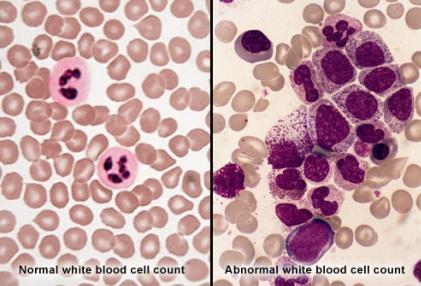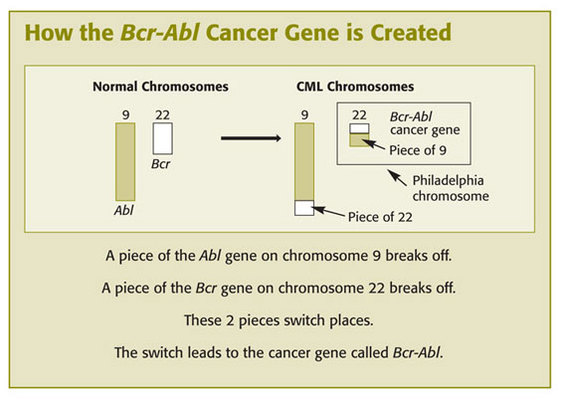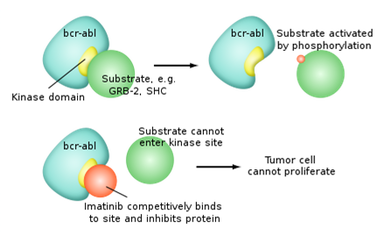This web page was produced as an assignment for Gen677 at UW-Madison Spring 2010
Chronic Myeloid Leukemia & ABL1

Normal blood sample compared to CML blood sample
Chronic myeloid leukemia (CML) is one of four main types of leukemia or cancer of the blood that affects about 24,800 people in the United States or about 15% of all leukemia cases
in the US. (2,6) Most of these cases occur in adults with the rate of occurrence increasing with age. Incidence is found throughout the world with the highest found in Switzerland and United States and the lowest in China and Sweden. (6)
CML is a hematopoietic stem cell disorder characterized by the transformation of a single myeloid stem cell in the bone marrow. (2,4,5,6) This single stem cell proliferates and eventually develops immature and an abnormal amount ofgranulocytes (white blood cells) that eventually lose their ability to fight infection. Other symptoms may include but not limited to joint pain, shortness of breath, hot flashes, anemia, basophilia, thrombocytosis, and splenomegaly.(6)
in the US. (2,6) Most of these cases occur in adults with the rate of occurrence increasing with age. Incidence is found throughout the world with the highest found in Switzerland and United States and the lowest in China and Sweden. (6)
CML is a hematopoietic stem cell disorder characterized by the transformation of a single myeloid stem cell in the bone marrow. (2,4,5,6) This single stem cell proliferates and eventually develops immature and an abnormal amount ofgranulocytes (white blood cells) that eventually lose their ability to fight infection. Other symptoms may include but not limited to joint pain, shortness of breath, hot flashes, anemia, basophilia, thrombocytosis, and splenomegaly.(6)
The severity of these symptoms determines the phase of disease. There are three phases:
1. The chronic phase is the first phase of CML. It is the easiest to treatment and mostpatients go into remission. There are generally no to very mild symptoms and is often diagnosed after examining ablood and/or blood marrow sample.
2. The accelerated phase is distinguished by an increase in blast cells from 5% to 15%.The symptoms become more severe and the disease becomes harder to treat.
3. The blast crisis phase is associated with an increase of blast cells to 30% of the blood composition. The granulocytes develop immaturely and can no longer fight infection. There is a decrease in red blood cells and platelets along with abnormal B and T cells. Other symptoms become very severe and the disease is very difficult to treat. This inability to treat and fight infection results in patient mortality.
1. The chronic phase is the first phase of CML. It is the easiest to treatment and mostpatients go into remission. There are generally no to very mild symptoms and is often diagnosed after examining ablood and/or blood marrow sample.
2. The accelerated phase is distinguished by an increase in blast cells from 5% to 15%.The symptoms become more severe and the disease becomes harder to treat.
3. The blast crisis phase is associated with an increase of blast cells to 30% of the blood composition. The granulocytes develop immaturely and can no longer fight infection. There is a decrease in red blood cells and platelets along with abnormal B and T cells. Other symptoms become very severe and the disease is very difficult to treat. This inability to treat and fight infection results in patient mortality.
A diagnosis is often confirmed through the use of blood and bone marrow tests. (2) The bone marrow test is used to detect the Philadelphia (Ph) chromosome, which is defined as the cause of CML in 95% of all cases. (5,6) The Ph chromosome is formed when a piece of chromosome 22 breaks off and joins at the end of chromosome 9. (2) The break on chromosome 22 occurs at a gene called the breakpoint cluster region (BCR). BCR then translocates and fuses with the Ableson leukemia virus (ABL1) gene to form the BCR-ABL fusion gene, which transcribes a tyrosine kinase protein which increases cell proliferation and reduces apoptosis in the granulocytes leading to CML. (5,6) The mechanism behind the breakage of these chromosomes and the translocation of the two genes is unknown.
ABL1
ABL1 is found on chromosome 9. It transcribes a protein kinase that is crucial to regulating the processes linked to cell growth and survival. (1) It does this by regulating the remodeling of the cytoskeleton during cell differentiation, cell division, and cell adhesion. Other proteins bind to the tyrosine kinase domain and are phosphorylated. This activates the binding protein and it is this protein that continues along the pathway and eventually causes the proliferation of the cell.
In the case of the BCR-ABL fusion gene, the BCR portion of the gene promotes the transcription of the ABL1 portion of the gene and other proteinsthat normally regulate ABL1 cannot bind. This increases the transcription of the BCR-ABL protein resulting excessive amounts of tyrosine kinase and phosphorylated proteins that promote cell proliferation. Tyrosine kinase inhibitors are used as treatment to block the kinase activity by binding to the tyrosine kinase domain and preventing phosphorylation of these other proteins. This decreases cell proliferation and controls the progression of CML.
References
1. http://www.uniprot.org/uniprot/P00519
2. http://www.lls.org/all_page?item_id=8501
3. http://www.genecards.org/cgi-bin/carddisp.pl?gene=ABL1&search=NG_012034
4. http://www.novartisoncology.us/education/diseases-conditions/hematology/cml.jsp
5. Melo J. V., Hughes, T. P., & Apperley, J. F. (2003). Chronic Myeloid Leukemia. Hematology, 132-152.
6. Sawyers, C. L. (1999). Chronic Myeloid Leukemia. The New England Journal of Medicine, 340, 1330-1340.
7. Lictman, M.A., Kipps, T.J., Seligsohn, U., Kaushansk, K., and Prchal, J.T. Chapter 90 Chronic Myelogenous Leukemia and Related Disorders. Williams Hematology, 8e. http://www.accessmedicine.com.ezproxy.library.wisc.edu/content.aspx?aid=6124901
8. http://library.kiwix.org:4201/A/Imatinib.html
2. http://www.lls.org/all_page?item_id=8501
3. http://www.genecards.org/cgi-bin/carddisp.pl?gene=ABL1&search=NG_012034
4. http://www.novartisoncology.us/education/diseases-conditions/hematology/cml.jsp
5. Melo J. V., Hughes, T. P., & Apperley, J. F. (2003). Chronic Myeloid Leukemia. Hematology, 132-152.
6. Sawyers, C. L. (1999). Chronic Myeloid Leukemia. The New England Journal of Medicine, 340, 1330-1340.
7. Lictman, M.A., Kipps, T.J., Seligsohn, U., Kaushansk, K., and Prchal, J.T. Chapter 90 Chronic Myelogenous Leukemia and Related Disorders. Williams Hematology, 8e. http://www.accessmedicine.com.ezproxy.library.wisc.edu/content.aspx?aid=6124901
8. http://library.kiwix.org:4201/A/Imatinib.html



